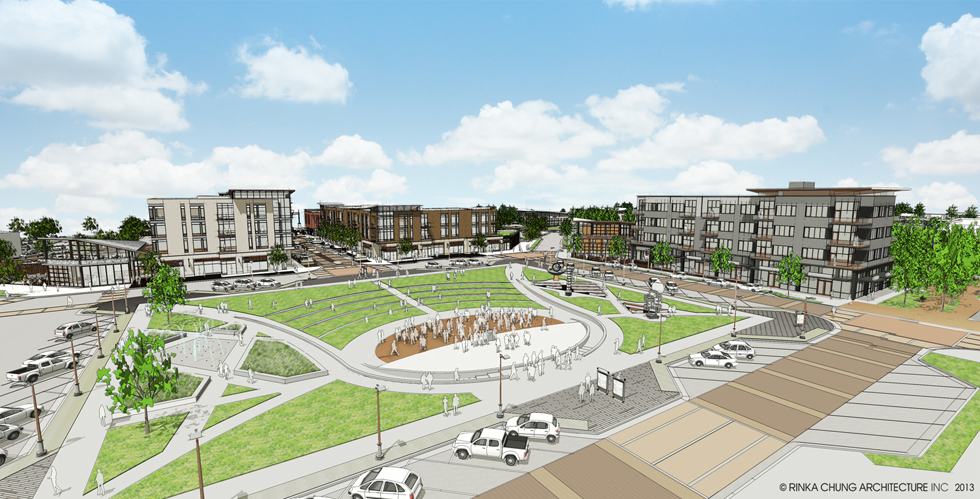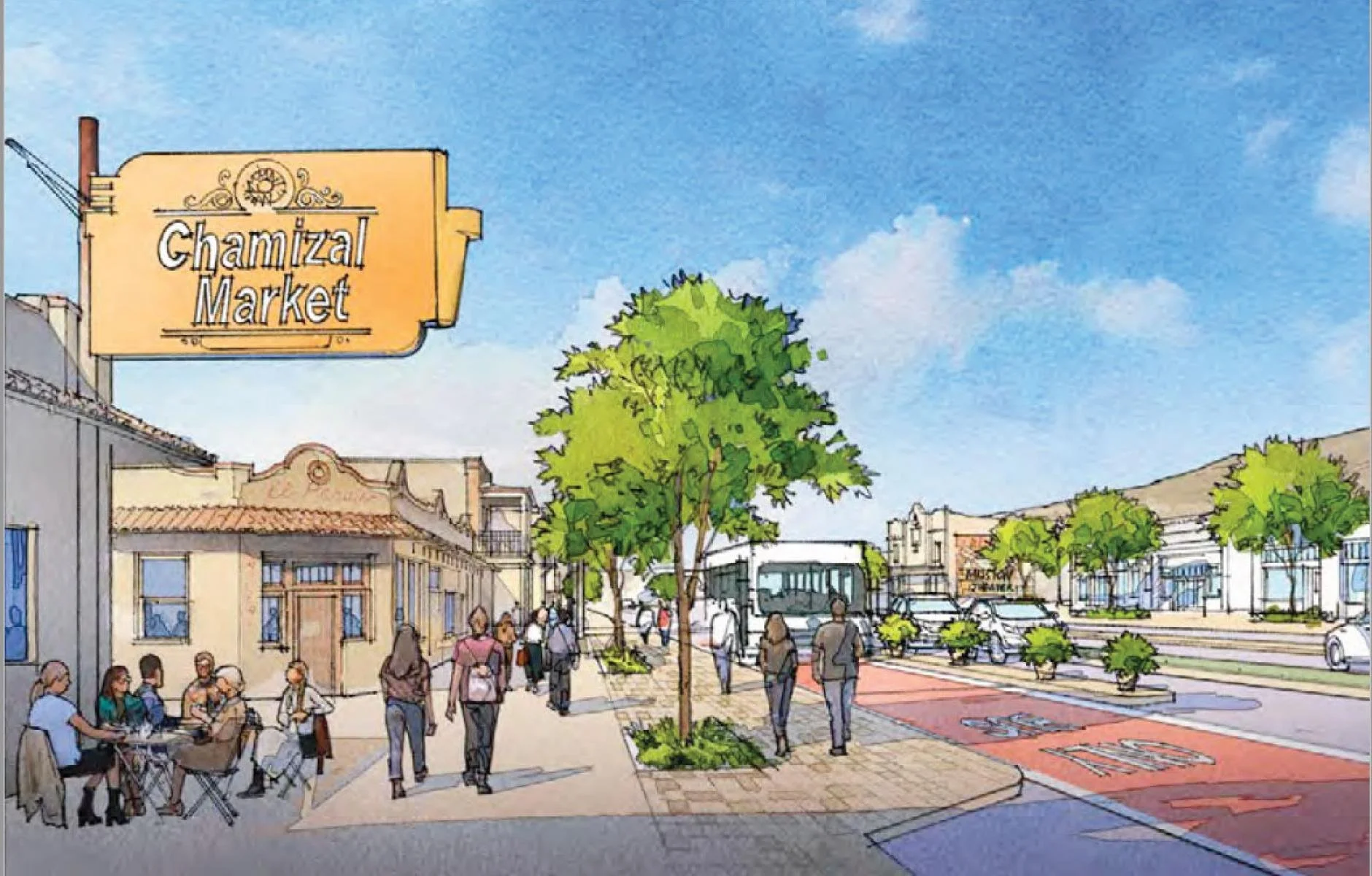A Town Square out of Thin Air
“It’s not “just like downtown.” It IS downtown.”
That’s the tagline for a new “town square” currently under construction in Oak Creek, Wisconsin (a second ring suburb of Milwaukee). Drexel Town Square is positioning itself as Oak Creek’s new downtown, but unlike traditional downtowns where businesses, residences and public spaces were built gradually over time, and tested and intensified as demand grew, this development is being created from the ground up for more than $150 million in public and private funding.
What is this place?
This video gives a pretty good sense of the vision for the 85 acre development. When completed (it’s partially finished already), Drexel Town Square will be home to a public library, city hall, wetland walking path, hotel and farmers market, as well as several restaurants (all national and local chains) and trendy mixed-use apartment buildings—all within walking distance of one another.
It might be a decent place to hang out, but if you want to visit, you’ll first need a car. The location (sandwiched between several stroads and big box stores) means that even if you live in one of the suburban-style neighborhoods nearby, you’re probably going to drive to the Town Square unless you want to endure an unpleasant and dangerous walk. Technically, the development is also connected to the Oak Leaf Trail—Milwaukee’s major bike trail. However, here’s what that "trail" looks like as you approach the Town Square:
(Image from Google Earth)
It’s not really a trail. It's a sidewalk next to a stroad. Or you can bike with the cars if you dare:
Who wouldn't want to bike along this? (Image from Google Earth)
The developers knew their audience so they made sure to put in hundreds of parking spots and their marketing materials make it clear that the walkable downtown is just an easy drive away:
Visitors and businesses alike enjoy the easy freeway access to Drexel Town Square via the I-94 Drexel Avenue Interchange.
The town square even has a “fuel center.” Now there is one way you could easily get to this Town Square on foot: by living in one of the apartments on site. Of course, you’d still need a car if you ever wanted to leave the area to get to, say, work, but this development at least offers the temporary illusion of being in a walkable area.
The gray space areas are almost all parking. (Rendering from Drexel Town Square website)
To that end, amidst the photos of stainless steel appliances, smiling multiracial couples, and $1,100+ a month price tags, the apartment complex’s website boasts:
The elevated position of the apartments homes keeps the angled parking below natural site lines of the ground-level homes improving the tranquility and visual continuity.
So, while you’re surrounded by a sea of parking, you won’t have to look at it! The apartment website continues with buzzwordy enthusiasm:
Centralized residential density grounds the array of public assets making it feel like a downtown city neighborhood within the broader suburban community.
Can a suburban “downtown” created from thin air succeed? Let’s look at the finances.
Who’s paying for this?
Under the headline, “Drexel Town Square complex promises to transform Oak Creek,” Milwaukee’s local paper, the Journal Sentinel, gave a rundown on the financing for this development in 2015. Here are some of the highlights:
- $38 million (almost 25% of the full cost) comes from the city of Oak Creek, although Drexel Town Square’s property taxes are supposed to pay that back by 2032.
- The city is also spending $20.5 million on the new library and city hall in the development.
- A $1 million grant from the Wisconsin Economic Development Corporation will go toward the construction of a parking ramp for a new medical center in the Town Square (see the large gray area in the top left corner of the above rendering).
- The city also allocated more than $11 million to revamp a highway interchange and widen a road near the development.
- And in more recent news, it was just announced that Oak Creek will provide $7.25 million in financing for additional apartment buildings on the Town Square, part grant and part loan.
The partially completed development. (Image from Drexel Town Square website)
We could spend a long time unpacking these funding dynamics, but I’ll summarize them for now: While the style of this development may be a little different from the typical cul-de-sacs, four lane speedways and fast food restaurants you'd find in a suburb, the funding mechanisms and long term outlook are exactly the same.
We’ve got a local government shelling out millions in the hopes of making that money back decades from now (cross your fingers) and the illusive promise of attracting new residents and businesses with this expensive project. The local government is also rolling out new infrastructure to support the development with little plan to pay for its maintenance. And don't get me started on the $1 million parking garage... Overall, this is a huge gamble (with millions in public dollars) on something that hasn’t been tested or experimented with in the slightest. In practice, it is no different from any large suburban project like a new mall or housing subdivision.
What’s more, the Town Square site is actually home to plenty of purely auto-oriented, suburban-style stores, in addition to its handful of walkable streets, revealing even more thoroughly its true suburban heart. The Journal Sentinel reports:
Initially, Wispark [Drexel Town Square’s developer] planned to have stores no larger than 20,000 square feet. But that plan was dropped, drawing opposition from some residents, because Drexel Town Square was unable to attract commercial tenants without a large anchor store.
"We could have never developed this entire site as a town center," Jerry Franke, [president of Wispark] said. "It would have failed miserably."
That's because Wispark, a division of Wisconsin Energy Corp., needed city cash through a tax incremental financing district to help pay for the site's roads, sewer and water lines and other public improvements, Franke said.
The Meijer store and other suburban-oriented buildings will play a key role in generating the property tax revenue to make the tax financing district work, Franke said.
A view of the town square entrance under construction from late 2016. Click to view larger. (Image from Google Maps)
The flawed assumptions here are numerous and reveal the convoluted layers of financing and bureaucracy at work. First, while the large anchor stores may provide more gross tax revenue for the city, on a per acre basis, they typically provide far less revenue than a smaller mixed-use development. In addition, they suck up far more public resources in the form of pipes, roads, and other utilities. Unlike more compact forms of development, big box stores also provide few to no options for reuse once the tenant inevitably decides to close up or move on.
But the big box anchor stores must be built in order to get TIF money from the city. And the city is banking on the revenue from the big box stores to support the whole endeavor so... how is this fresh, expensive faux "downtown" anything new?
It might not comes as a surprise that the main developer behind Drexel Town Square, Wispark LLC’s previous experience is primarily in building suburban office parks. Wispark is applying the same model they use with office parks to this slightly different style of development, but I have a hunch that the result will ultimately be the same—empty buildings and lagging taxes within a couple decades. It’s a style of development that does not pay for itself.
What does a traditional downtown look like and what makes it successful? Learn in this sixth video from our Curbside Chat series.
Is this worth it?
I think you can probably guess my answer to this question: No.
I tried to approach this project with an open mind and find something to love about it, but it just leaves a bad taste in my mouth. Sure, it makes use of an old, vacant space and gives a thoroughly auto-oriented area a slice of the walkable, mixed-use life.
But it's born out of the same shortsighted mindset of “build all at once" at immense public cost that gave us the suburbs. It will bring with it all the usual problems of the suburban development pattern: expensive maintenance costs for roads and utilities that have not been adequately planned for, low value per acre, and a fragile reliance on only a handful of backers and developers.
You may respond with, but don’t the Oak Creek residents deserve a downtown too? Don’t they get points for trying? My response is: not at the cost of over $150 million.
What makes downtowns successful and worthwhile? Is it the mere fact that they have sidewalks and restaurants and apartments clustered together? Or is it because they are built incrementally over time, from a few shacks erected by the initial settlers to small structures and later, if they're profitable and stand the test of time, larger multi-story buildings? This method of building allows ideas to be tested and refined, businesses to flourish and fail, communities to come and go. Through trial and error, it produces the central gathering place that a town desires. Spending hundreds of millions of dollars in an attempt to manufacture this over the course of a couple years is a fools errand.
Drexel Town Square may have the appearance of a "town center," but its inception, its financing and its long-term outlook are no different from any of the big box stores and cul-de-sac subdivisions that surround it. Drexel Town Square is not "just like downtown." And it's definitely not downtown.











Our most famous case study revealed the high cost of auto-oriented development. But what if a little creative rearrangement could make things a whole lot better?